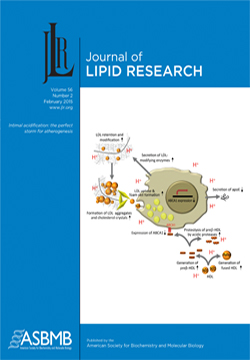JLR: Molecular insights and potential therapies for Niemann–Pick C disease
A recent thematic review in the Journal of Lipid Research from Jean E. Vance and Barbara Karten summarizes the molecular mechanisms that underlie the lysosomal storage disease Niemann–Pick C and discusses the development of therapies for patients with this disorder.
 NPC disease is a progressive, inherited disease that affects about one in 150,000 births. In NPC disease, unesterified cholesterol accumulates in late endosomes/lysosomes, called LE/Ly for short, of all cells. This accumulation occurs in all tissues but most notably affects the brain, liver, spleen and lungs, resulting in neurodegeneration as well as liver and lung dysfunction.
NPC disease is a progressive, inherited disease that affects about one in 150,000 births. In NPC disease, unesterified cholesterol accumulates in late endosomes/lysosomes, called LE/Ly for short, of all cells. This accumulation occurs in all tissues but most notably affects the brain, liver, spleen and lungs, resulting in neurodegeneration as well as liver and lung dysfunction.
The authors discuss NPC1, a transmembrane protein in the limiting membrane of LE/Ly, and NPC2, a soluble protein in the LE/Ly lumen, and how mutations of these proteins result in NPC disease. The authors point out that about 95 percent of NPC patients have mutations in NPC1, while the remaining cases are caused by mutations in NPC2. Mutations in either of these proteins result in reduced egress of low-density lipoprotein-derived cholesterol from LE/Ly.
In normal physiology, NPC2 binds unesterified cholesterol that is generated from endocytosed lipoproteins and transfers the cholesterol to the cholesterol-binding domain of NPC1. Cholesterol is then exported from LE/Ly to other destinations in the cell by unknown mechanisms. Mutations in either NPC1 or NPC2 result in cholesterol sequestration in LE/Ly and dysregulation of multiple cellular processes that lead to organ dysfunction.
The authors discuss the development of models used to study NPC disease and explain how NPC deficiency affects cells of the brain. Several cellular and animal models are available for studying NPC disease. The most widely used models are mice in which either NPC1 mutants are expressed or amounts of NPC1 or NPC2 proteins are reduced. These models have shown that, as in human NPC patients, one of the most dramatic consequences of mutation or reduction of NPC proteins is loss of Purkinje neurons in the cerebellum. However, the authors point out that the reason Purkinje neurons are particularly sensitive to defects in NPC1/NPC2 and the mechanisms underlying the neuropathology characteristic of NPC disease remain unclear.
Currently, no effective treatment is available for NPC disease. The glucosylceramide synthase inhibitor miglustat produces modest improvements in disease phenotypes in animal models. Also, a histone deacetylase inhibitor reduces cholesterol accumulation in NPC-deficient cells but has not yet been tested in animals.
The authors of the JLR review focus on the cholesterol-binding agent 2-hydroxypropyl-β-cyclodextrin, or CYCLO, that markedly delays neurodegeneration and extends the lifespan of NPC-deficient animals with minimal toxicity. Interestingly, for reduction of cholesterol accumulation in cellular models of NPC disease, CYCLO must be taken into the cell and delivered to LE/Ly, thereby bypassing the functional need for both NPC1 and NPC2.
Vance and Karten note that this very exciting finding from John Dietschy’s lab at the University of Texas Southwestern Medical Center at Dallas has led to a promising NPC treatment approach for which a clinical trial is underway.
The authors also consider the limitations of using cyclodextrins, such as CYCLO, as a therapy for NPC disease. One major limitation is poor penetration of CYCLO across the blood-brain barrier. To circumvent this problem, researchers are working to improve CYCLO delivery in cellular and animal models. As the authors note, while the identification and validation of CYCLO as a potential NPC therapy is encouraging, there is still work to be done to determine whether or not CYCLO will be effective.
Enjoy reading ASBMB Today?
Become a member to receive the print edition monthly and the digital edition weekly.
Learn moreGet the latest from ASBMB Today
Enter your email address, and we’ll send you a weekly email with recent articles, interviews and more.
Latest in Science
Science highlights or most popular articles

National Academies propose initiative to sequence all RNA molecules
Unlocking the epitranscriptome could transform health, medicine, agriculture, energy and national security.

From the journals: JLR
What can you do with artificial lipoproteins? A new key to angiogenesis. Flavonoids counteract oxidative stress. Read about recent papers on these topics.

Iron could be key to treating a global parasitic disease
A study has found that leishmaniasis causes body-wide changes in iron balance, leading to red blood cell damage.

Environmental DNA is everywhere
The ability to extract trace bits of DNA from soil, water, and even air is revolutionizing science. Are there pitfalls?

Early COVID-19 research is riddled with poor methods and low-quality results
The pandemic worsened, but didn’t create, this problem for science.

From the journals: MCP
Three views of mass spec: analyzing secreted protein spectra, imaging mass spectrometry for clinical use and spectral libraries for MS data analysis. Read about these recent papers.

